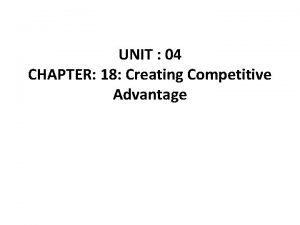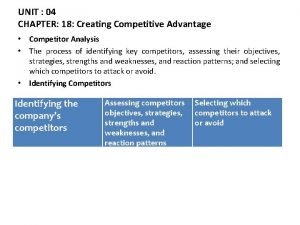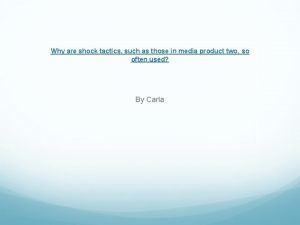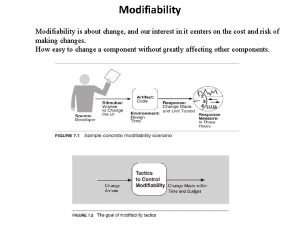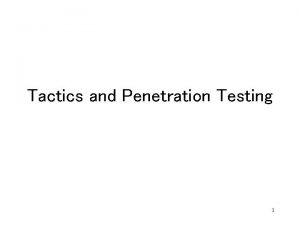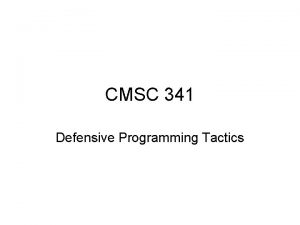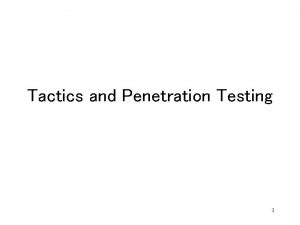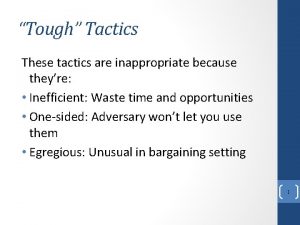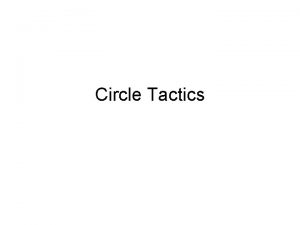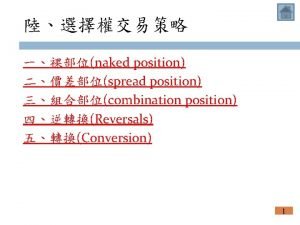Chapter 4 Competitive Position Tactics Competitive position tactics


























![Multiple Niching “[A] firm should `stick to its niching’ but not necessarily to its Multiple Niching “[A] firm should `stick to its niching’ but not necessarily to its](https://slidetodoc.com/presentation_image/56359ae8f7674a6f49efd149f3300397/image-27.jpg)
- Slides: 27

Chapter 4 Competitive Position Tactics

Competitive position tactics

Strategies for Market Leaders Market Leader’s objectives: • Expand the total market by – Finding new users – Creating new uses, and – Encouraging more usage (quantity and frequency) • Protect its current market share by – Adopting defense strategies (see defense stategies) • Increase its market share – Market share = Company sales / Industry sales – Factors considered for the expansion of market share includes price, new product, service, quality/strength of marketing, advertising and sales promotion etc.

Which strategy to use? Depends on your answer to the following: • Is it worth fighting? • Are you strong enough to fight? • How strong is your defense? • Do you have any choice but to fight?

Which strategy to use? • “Move only if there is a real advantage to be gained …” • “If our force is ten times the enemy’s, then surround him; five times his, attack him, if double his, divide our force into two and use as ‘alternative strategy’; if only equal his, we must concentrate our force to fight him…if our force is so much weaker than the enemy’s, we should totally avoid him. ” • “If I know my soldiers are capable of attacking the enemy but unaware that he is invulnerable to attack, my chance of victory is but half…If I know he can be attacked and my soldiers are capable of doing it but are unaware that the terrain is unsuited for fighting, I should hold back for my chance of victory is but half. ” • “Do not fight unless you are in danger” • “One who has few must prepare for defense; one who has many shall make the enemy prepare for defense. ”

Defense Strategy • A market leader should generally adopt a defense strategy • Six commonly used defense strategies – – – Position Defense Mobile Defense Flanking Defense Contraction Defense Pre-emptive Defense Counter-Offensive Defense

Position Defense • Occupying the most desirable position in consumers’ mind and building fortifications around that position • Simply defending current position rarely works • Example – P & G ‘owns’ the key functional benefit in many product categories – Tide Detergent for cleaning – Crest toothpaste for cavity prevention – Pamper diapers for dryness

Flanking Defense • an area where the company has yet to establish a strong position (flanks) are the weaker regions and prone to being attacked • Example : – Nokia made budget-oriented ‘Asha phone’ to compete with the Chinese and Indian brands. – Offering new menu to regional branches to bit the native brands

Pre-emptive Defense • Company decides to attack competitors before it is attacked by them • Typical option includes – attacking competitors here and there simultaneously (the shotgun attack) instead of attacking only one at a time (the rifle attack). – Attacking covering a huge market thru extensive distribution – Attacking with significant price reduction – Creating psychological pressure on competitors (Psychological warfare) • Product or brand proliferation is a form of pre-emptive defense • Example - Seiko has over 2, 000 models

Counter-Offensive Defense • Responding to competitors’ head-on attack by identifying the attacker’s weakness and then launch a counter attack • Common forms include – straight invasion into the leader’s territory. – exercise of economic or political clout ( Tech leaders like Intel, MS, Apple defended their brands in court), – Stabilize lower price for the vulnerable products etc. • Example - Toyota launched the Lexus to respond to Mercedes attack

Mobile Defense • the leader in addition to defending his existing territories, expands into areas which are prospective. • Occurs market broadening and diversification • For market broadening, there is a need to – Redefine the business (principle of objective) – Focus on efforts of the competition • Example- When Philip Morris and Reynolds acknowledged growing curbs on cigarette smoking, they moved into industries like beer, liquor, soft drinks and frozen foods

Contraction Defense • The leader decides to give up weaker territories and reassigning resources to stronger ones • By ‘planned contraction’ or ‘strategic withdrawal • Example: – India’s TATA Group sold its soaps and detergents business units to Unilever in 1993 – Ford retires T-birds and Probe and Focuses on Contour & Taurus

Market Challenger Strategies The market challengers’ strategic objective is to gain market share and to become the leader eventually • By attacking the market leader • By attacking other firms of the same size • By attacking smaller firms

Market Challenger Strategies Types of Attack Strategies • Frontal attack • Flank attack • Encirclement attack • Bypass attack • Guerrilla attack

Frontal Attack • The firm launches direct attack against the opponent on its strength – by offering similar products (in terms of features or performance), – by matching the price with the defender, – by following the same promotion and distribution policies followed by the defender • Seldom work unless – The challenger has sufficient fire-power (a 3: 1 advantage) and staying power, and – The challenger has clear distinctive advantage(s) • Example Pepsi Vs Coke – Diet Pepsi – Diet coke

Flank/ Peripheral attack • Attack the enemy at its weak points or blind spots or flanks (depicts sides) • Ideal for challenger who does not have sufficient resources • LG outflanked the other colored TV producers in India, by launching a rural-specific color TV “Sampoorna”, thereby becoming the first one to tap the rural areas.

Encirclement attack • Attack the enemy at many fronts at the same time • Competitor attacks another on the basis of strength as well as weaknesses • The fronts, rears, and sides are attacked at a time, and all on a sudden and the opponents become puzzled and start protecting all fronts • Ideal for challenger having superior resources • Example - Seiko attacked on fashion, features, user preferences and anything that might interest the consumer

Bypass attack • An indirect attack by a challenger that avoids opponents on direct fronts • Seek new business through major technological development or going for new markets with new products Could overtake the leader by using new technologies • Example - What did Ipod do to the Sony walkman?

Guerrilla attack • Consists of waging small, intermittent hit-and-run attacks to harass and demoralize the opponent and eventually seek permanent footholds. • Includes price cuts, promotion offering special inducements, coupons, or premiums, product improvements or modification, wider distribution, legal attacks and so on. • Best suited to smaller companies with limited resources • e. g. airlines use short promotions to attack the national carriers especially when passenger loads in certain routes are low


Which Attack Strategy should a Challenger Choose? • Use a combination of several strategies to improve market share over time • Strategies will change depending on the competitor whom one targets

Market-Follower Strategies • Theodore Levitt in his article, “Innovative Imitation” argued that a product imitation strategy might be just as profitable as a product innovation strategy e. g. Product innovation--Sony Product-imitation--Panasonic

Four broad follower strategies • Adapter – takes the leader’s products and adapts and improves them – Many Japanese firms are excellent adapters initially before developing into challengers and eventually leaders • Imitator – copies some product features of competitors’, but maintains differentiation in terms of packaging, advertising, pricing or location – car manufacturers imitate the style of one another – Tata Sky -Videocon, Airtel, Reliance

Four broad follower strategies • Cloner involves manufacturing of slightly altered products – Emulates the leader’s produts, name and packaging with slight variations – Example: Gucci – GUCCA, Rado – RADA – Counterfeiter – A black market follower strategy that involves thieving by duplicating the leader’s products – Example: Pirated DVDs and CDs of movies and music

Market-Nicher Strategies • Goal is to be a large fish in a small pond rather than the other way around • Smaller firms can avoid larger firms by targeting smaller markets or niches that are of little or no interest to the larger firms • Intimately know their customers and better meet their needs • Example: software firms supplying law firm related software

Market-Nicher Strategies (cont’d) • Nichers must – create niches, – expand the niches and – protect the niches • In a study of hundreds of business units, the Strategic Planning Institute found that return on investment averaged 27% in small markets, but only 11% in larger markets • What is the major risk faced by nichers? – Market niche may be attacked by larger firms once they notice the niches are successful
![Multiple Niching A firm should stick to its niching but not necessarily to its Multiple Niching “[A] firm should `stick to its niching’ but not necessarily to its](https://slidetodoc.com/presentation_image/56359ae8f7674a6f49efd149f3300397/image-27.jpg)
Multiple Niching “[A] firm should `stick to its niching’ but not necessarily to its niche. That is why multiple niching is preferable to single niching. By developing strength in two or more niches the company increases its chances for survival. ” Philip Kotler
 Slow cycle market
Slow cycle market Second position echappe
Second position echappe Market structure from most competitive to least competitive
Market structure from most competitive to least competitive Competitive antagonist
Competitive antagonist Strengthening a company's competitive position
Strengthening a company's competitive position Target market attractiveness
Target market attractiveness Price benefit positioning map
Price benefit positioning map Chapter 18 creating competitive advantage
Chapter 18 creating competitive advantage Chapter 18 creating competitive advantage
Chapter 18 creating competitive advantage 5 generic competitive strategies
5 generic competitive strategies Chapter 13 game theory and competitive strategy
Chapter 13 game theory and competitive strategy Chapter 2 strategic planning for competitive advantage
Chapter 2 strategic planning for competitive advantage Chapter 18 creating competitive advantage
Chapter 18 creating competitive advantage Firms in competitive markets chapter 14 ppt
Firms in competitive markets chapter 14 ppt Chapter 18 creating competitive advantage
Chapter 18 creating competitive advantage Fundamental position vs anatomical position
Fundamental position vs anatomical position Position fundamental
Position fundamental Shock tactics examples
Shock tactics examples Hierarchy of strategic intent
Hierarchy of strategic intent Interoperability quality attribute
Interoperability quality attribute Unethical political tactics and strategies
Unethical political tactics and strategies Patrol tactics training
Patrol tactics training Modifiablity
Modifiablity Tcu criminal thinking scales
Tcu criminal thinking scales What tactics were used to win the “revolution of 1875”?
What tactics were used to win the “revolution of 1875”? Nibble tactic
Nibble tactic Ashley drew scare tactics
Ashley drew scare tactics Krissy cross
Krissy cross







